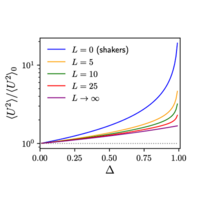Abstract
Active matter exhibits various forms of nonequilibrium states in the absence of external forcing, including macroscopic steady-state currents. Such states are often too complex to be modeled from first principles, and our understanding of their physics relies heavily on minimal models. These are mostly studied in the case of “dry” active matter, where particle dynamics are dominated by friction with their surroundings. Significantly less is known about systems with long-range hydrodynamic interactions that belong to “wet” active matter. Dilute suspensions of motile bacteria, modeled as self-propelled dipolar particles interacting solely through long-ranged hydrodynamic fields, are arguably the most studied example from this class of active systems. Their phenomenology is well established: At a sufficiently high density of bacteria, there appear large-scale vortices and jets comprising many individual organisms, forming a chaotic state commonly known as bacterial turbulence. As revealed by computer simulations, below the onset of collective motion, the suspension exhibits very strong correlations between individual microswimmers stemming from the long-ranged nature of dipolar fields. Here, we demonstrate that this phenomenology is captured by the minimal model of microswimmers. We develop a kinetic theory that goes beyond the commonly used mean-field assumption and explicitly takes into account such correlations. Notably, these can be computed exactly within our theory. We calculate the fluid velocity variance, spatial and temporal correlation functions, the fluid velocity spectrum, and the enhanced diffusivity of tracer particles. We find that correlations are suppressed by particle self-propulsion, although the mean-field behavior is not restored even in the limit of very fast swimming. Our theory is not perturbative and is valid for any value of the microswimmer density below the onset of collective motion. This work constitutes a significant methodological advance and allows us to make qualitative and quantitative predictions that can be directly compared to experiments and computer simulations of microswimmer suspensions.
2 More- Received 18 December 2019
- Revised 9 April 2020
- Accepted 21 July 2020
DOI:https://doi.org/10.1103/PhysRevX.10.031059
Published by the American Physical Society under the terms of the Creative Commons Attribution 4.0 International license. Further distribution of this work must maintain attribution to the author(s) and the published article’s title, journal citation, and DOI.
Published by the American Physical Society
Physics Subject Headings (PhySH)
Popular Summary
Dilute suspensions of microswimmers, such as mobile bacteria, have recently emerged as a novel class of nonequilibrium systems with unique properties. By agitating the suspending fluid, microswimmers drastically alter the system’s transport properties leading, for example, to enhanced diffusion of tracer particles and apparent superfluidlike behavior. At sufficiently high concentration, bacterial suspensions exhibit collective motion with many organisms self-organizing into large-scale vortices and jets, reminiscent of bird flocks or fish schools. Surprisingly, recent simulations indicate that signatures of collective motion can be found even in very dilute suspensions where bacterial motion was believed to be random. To understand the origin of such strong correlations, here we study a minimal model of a dilute suspension of microorganisms that interact through long-range hydrodynamic interactions.
We overcome a significant technical difficulty that restricted previous work to nonmotile organisms, and explicitly include self-propulsion in our model. We show that the faster a bacterium swims, the more independent of other bacteria it becomes below the onset of collective motion, thus restoring the simple “disorder-collective motion” transition scenario for fast swimmers.
Our work sheds light on the nature of many-body hydrodynamic interactions and their role in the transition to collective motion in “wet” active matter systems. The methodological advance we achieve should be directly applicable to other active systems where long-range hydrodynamic interactions and self-propulsion are important.



